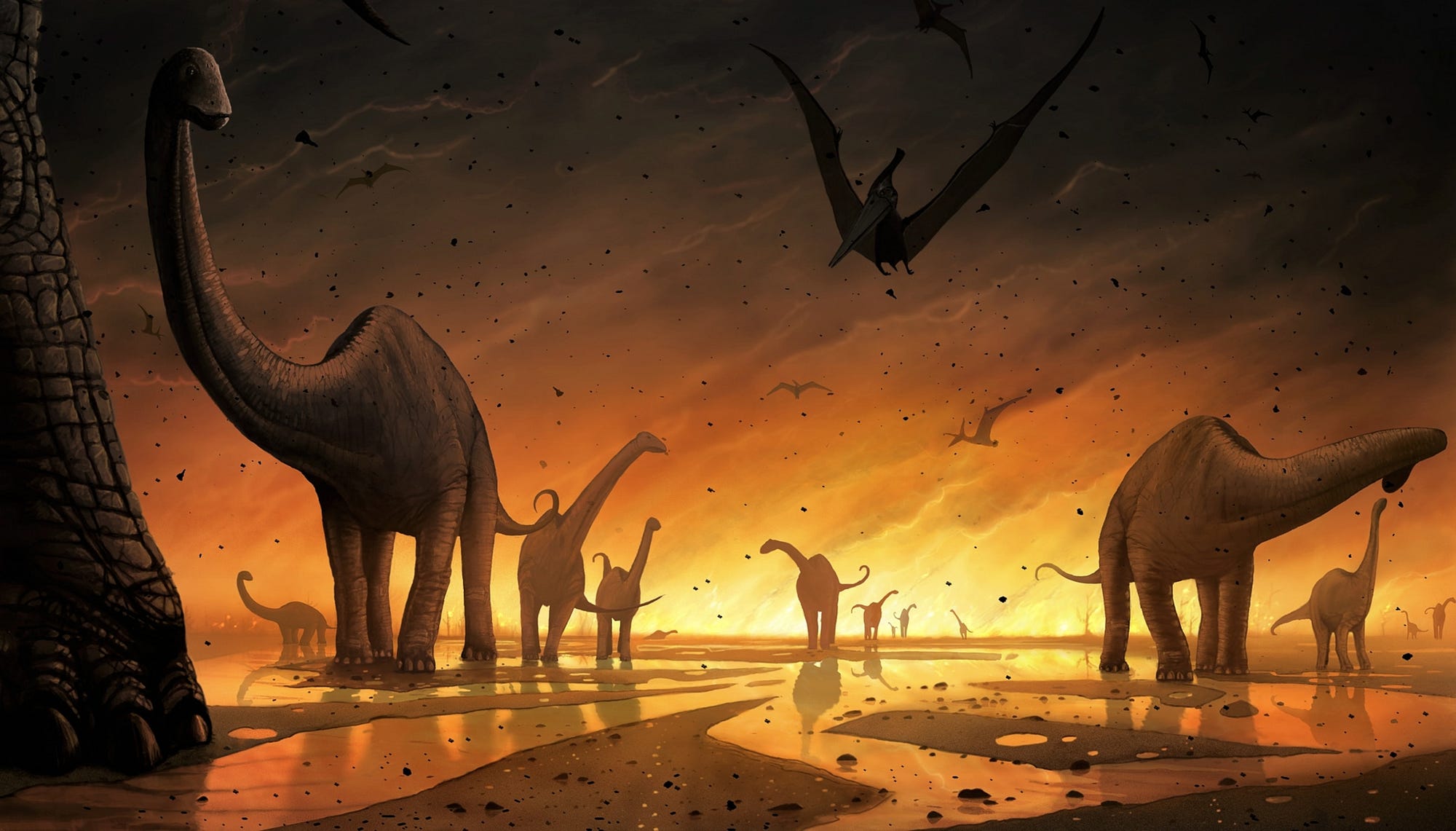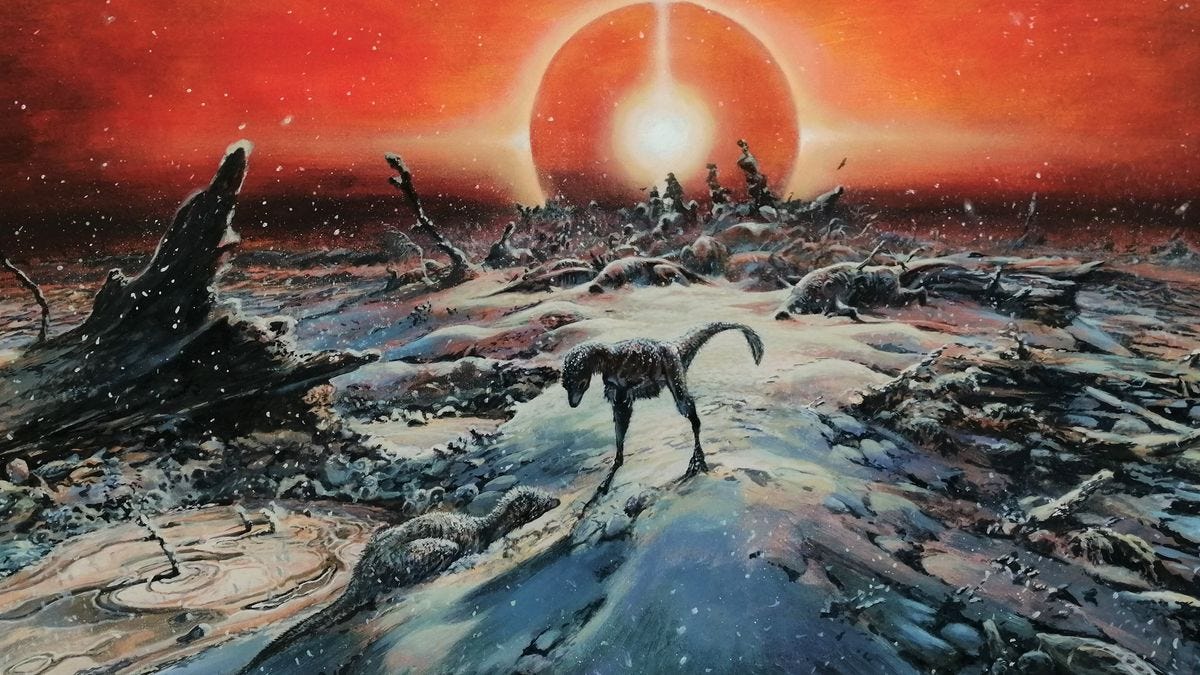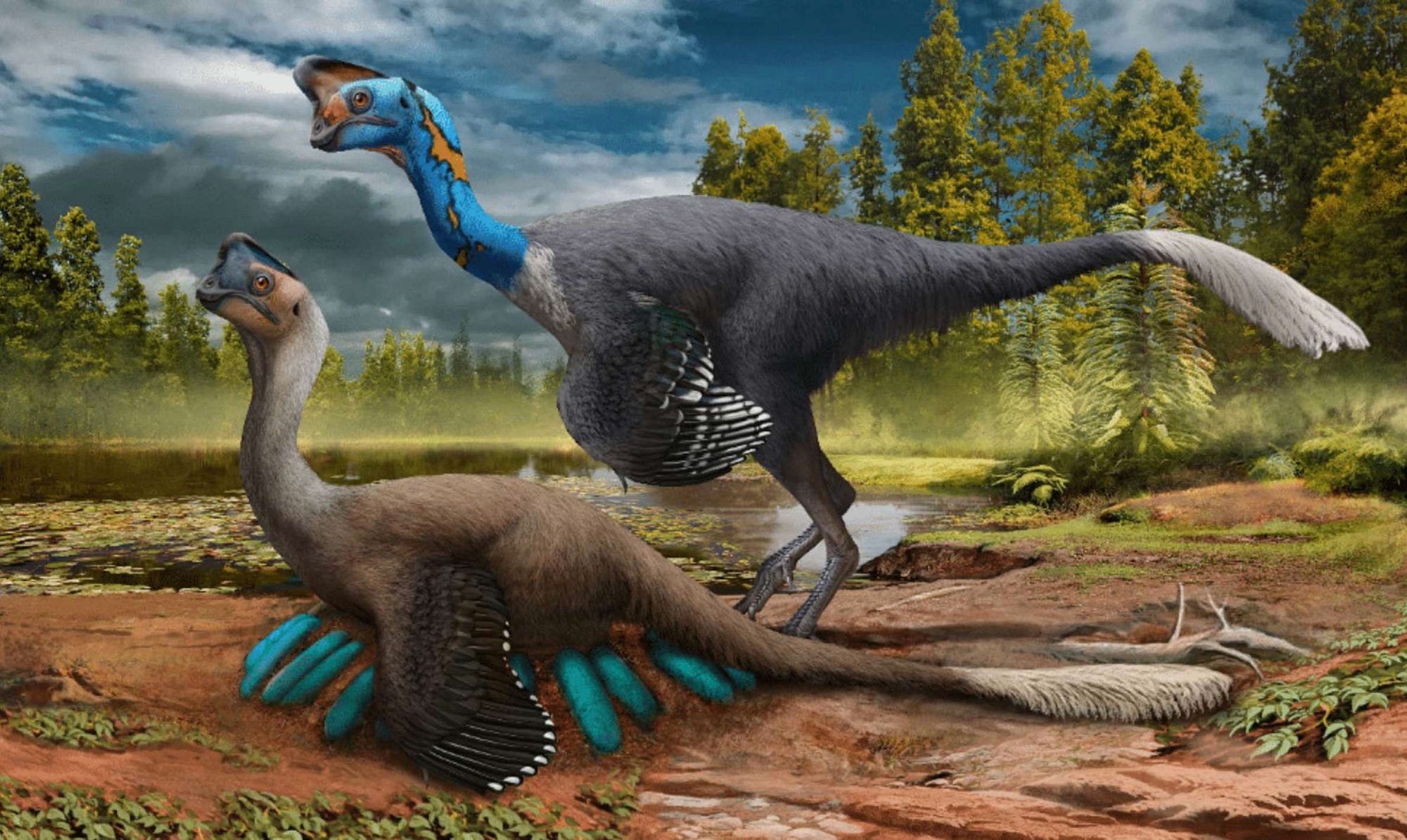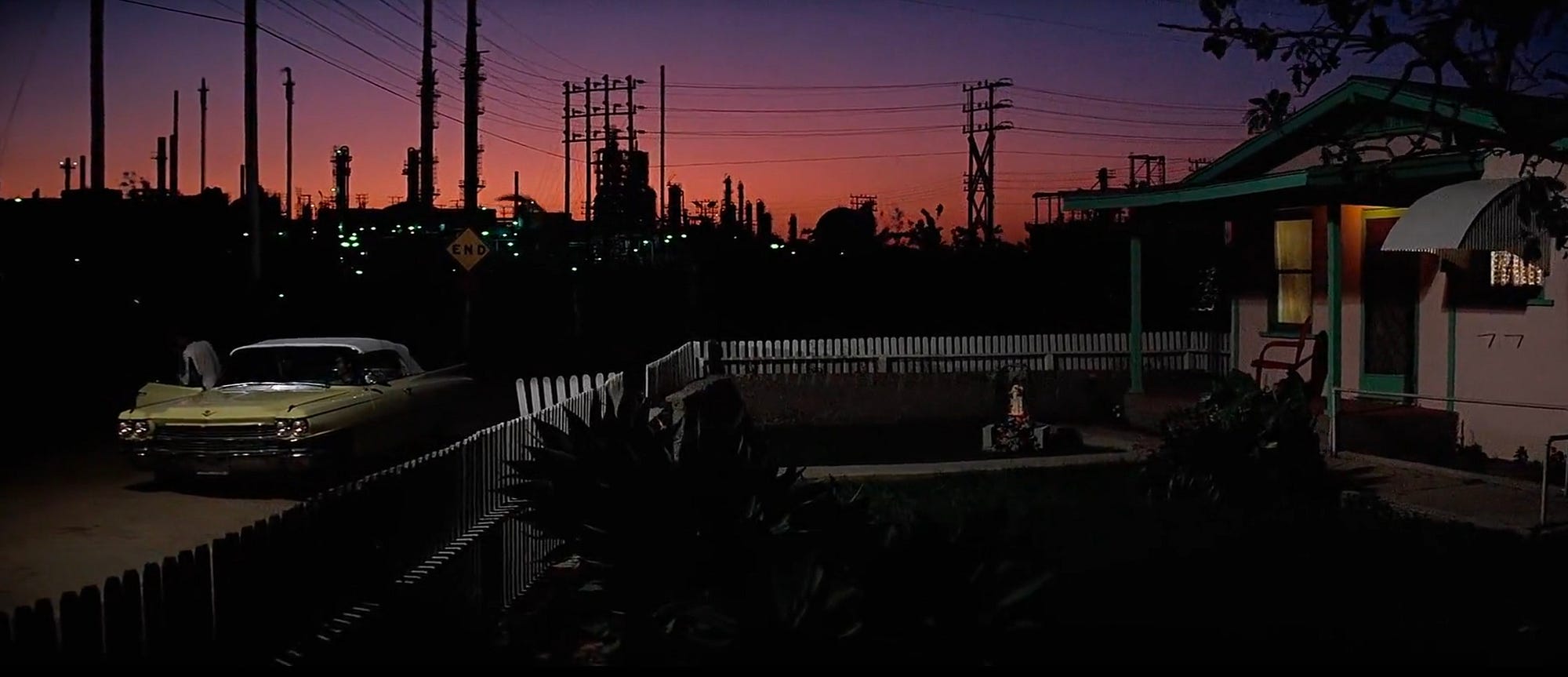Extinction Lessons From The Dinosaurs

The dinosaurs dealt with much worse climate change than us (the air was literally on fire) and somehow survived. The terrible lizards got shrunk down to rotisserie size, but they were still alive. After thousands of years, they even thrived, coming back as ‘terror birds’ in time. As I’ve written, we should be so lucky.
As Riley Black wrote in her book The Last Days Of The Dinosaurs, there’s a few lessons we can learn from the dino’s ‘demise’ as we face our own decline. I’ll cover the two lessons here. One is that extinction is avoidable, but that shrinking our ambitions is not.
1. Extinction Is Avoidable

The first lesson is that the dinosaurs did not go extinct. This has been hotly debated, but is now mostly settled. Birds are dinosaurs, ergo extant, not extinct. As Black said, “Birds were not simply waiting in the wings when the asteroid struck. They were part of the great flowering of dinosaur diversity, their roots anchored deep in the Jurassic.”
What did go extinct are the big dinosaurs. These unfortunate beasts got alternately fried, baked, frozen, and then had their bones literally dissolved in acid (rain). Their world was literally rocked and it’s a miracle they came out in any form at all. Immediately after impact (if you weren’t hit, tsunami’d or earthquaked to death), much of the atmosphere turned into a goddamn air fryer. Temperatures reached 260℃, which makes modern climate change look like a cakewalk. Then all the debris blocked out the sun, dropping temperatures 60℃ and leading to a near collapse in the whole food chain.
Only a few creatures could survive the immediate heat and even fewer could survive the cold. Nobody with big appetites could survive at all. The big dinosaurs had simply reached the end of the line. They were done.
‘Big’, however, is not synonymous with ‘dinosaur’. Birds were able to come off the dinosaur bench and, eventually, thrive. As Black said, “the meek inherit the Earth — and they had done so four times before.” That category included our shrew-like mammal ancestors, but also crow-sized dinosaurs. As Black said, “No dinosaur larger than the size of a raven survived the terrible pressures of the heat pulse and impact winter.” But survive they did.
Even Lord Shiva hurling a mountain at the planet could not extinct the dinosaurs. Many dinosaurs survived, and indeed out-speciated mammals over time. Quoth the raven, “forevermore.” The dinosaurs are still here, as you must know. The giants are gone, but the genus lives on. As Black said about the aftermath,
The time of giants is over. This little fluttering thing is what remains of the great dinosaurian legacy, one of the few surviving terrible lizards. There’s no common name for the bird: humans capable of giving it one won’t appear for about another 66 million years. But this is a ground-dwelling bird. A beaked bird. A bird set for survival even though it could have no idea what saved it or what would allow its descendants to thrive through subsequent ages.
The point here is that extinction is not inevitable. Indeed, it seems unlikely. What we call climate collapse is a few degrees rise in temperature, not a full-on oven/freezer combo, delivered from outer space with great violence. Humans also have decades to (theoretically) adapt, unlike the dinosaurs who had, at best, hours. As Black said, “To date, no one has found conclusive evidence that any non-avian dinosaurs survived for more than a few hours into the Paleocene.” Humans simply much more time to adapt and much less change to adapt to.
I, of course, am talking about humans the animal, which is not what most people mean when they talk about extinction at all. For most modern humans, mere survival would be a humiliation, we’d be living like animals, perish the thought. ‘Civilized’ humans made the decision to separate ourselves from the animals long ago. Now we’re surprised that this literally separates us from the animals, ie causes mass extinction.
Humans miss the fundamental point that we are animals, and that we’re ultimately just killing ourselves. As the Burna Boy song goes, “Apart, when I couldn’t see, I was cheating on, cheating on me.” Asking whether we can keep this civilization going is like asking the asteroid to ‘hit me baby, one more time.’ Fuck the asteroid, and fuck this civilization! Both burn up upon impact, inshallah.
Even now — as the projectile we’re riding is crashing — we’re trying to take all our luggage and wear high heels down the emergency escape. This is simply not how survival works. We’re lucky to escape with our skins, so leave the Louboutins! This is of course unimaginable for most people, so we’re going to keep making things worse until the very end. And in the end, we won’t all die, but for many people, all will be lost.
Human civilization is a product of a particular climate and modern civilization is a product of a particular energy supply. When the energy runs out and the climate changes Homo sapiens will probably still be here, but in dramatically reduced circumstances. That’s the main lesson from the dinosaurs. They’re here, but in such reduced circumstances that we don’t even recognize them anymore.
As Black said, “There will never be creatures as large and prolific as the non-avian dinosaurs ever again.” In the same way, I don’t think there will ever be an artificial civilization like this again, with giant, globe-spanning nations and corporations (artificial life). All the big dinosaurs got destroyed by their extinction level event, and our extinction level event is where big dreams come to die. The dinosaurs got wicked unlucky, but in our case, we are the asteroid.

2. The Meek Inherit The Earth
The type of creatures that survived the K-Pg event were the least dinosaury (re: awesome) imaginable. These critters were small, low to the ground (preferably underground), could live off scraps, and could ideally live on nothing at all (ie, hibernate). High-energy, high-consumption dinosaurs were gone. The downsizing started from the bottom of the food chain and trickled up.
As Black wrote about plants,
The plants with the best chance are those that evolved to tolerate low-light conditions, those often kept in the shade by taller trees of the Cretaceous world or that otherwise, by sheer luck, could get by on less. Low to the ground, a small, spindly branch pokes up from the soil.
Small plants meant small herbivores, and small carnivores. Ideally omnivores, who could eat whatever was around. The big ‘uns were out and ambitions would now have to be small. As Black describes, tiny seeds were among the few reliable forms of nutrition.
After the heat, the fires, and the cessation of sunlight, seeds are among the only accessible foods left. Beaked birds, or at least those adapted to breaking down tough foods inside their bodies, are able to seek out and persist on the great seed bank that was left behind by the charred forests. Each seed presents possibility, and, ingested, make hope the thing with feathers.
Black also compared frugal oviraptorosaurs (dinobirds) and gluttons like the T-Rex:
The ancestors of beaked birds — as well as some non-avian dinosaurs, such as the parrot-like oviraptorosaurs — evolved gizzards. That opened up the possibility of beaks. These dinosaurs did not need teeth to catch, kill, or break down their meals. They could focus on small prey like insects, lizards, mammals, and plants, plucking morsels to their reptilian heart’s content and swallowing that food whole. Those meals would then be ground down by the gizzard, allowing the animals to draw in more nutrition, faster, than other dinosaurs. (Other species, such as herbivorous dinosaurs, increased the amount of time food stayed in their digestive systems by means of hindgut fermentation similar to today’s elephants. Predators like T. rex simply filled their bellies and let the food run through quickly, effectively wasting food that could have fueled them and thus needing to eat greater quantities to keep up with the inefficiency.)
After the asteroid, inefficient creatures like T-Rex couldn’t survive (there was no surplus) and efficient scrabblers like birds inherited the Earth. This tells us something about modern times.
Today, American diets require 10 kcal of energy to produce every calorie of food. Globally, the green revolution is in fact black, huge amounts of energy are used for fertilizer and industrial farming. Across the world, huge amounts of food and energy are just wasted. Our food cultures are all T-Rex’s of one sort or another. This sort of decadent diarrhea was not long for the dinosaur world and it’s not long for this one either. High energy, high consumption creatures simply don’t do well during low energy, high destruction times. As Black wrote,
After all, the dinosaurs were diverse, disparate, extremely active, and always, always hungry. Under the stress of the catastrophe, all that was left of them were small, feathery creatures that poked around in the dirt for whatever seeds and insects they could find.
The same thing will happen to the disparate, extremely active, money hungry ‘hustle’ culture of today. All that will be left of billionaires and landlords will be “bones and ash” as Riley said, “Life [will go] back to a smaller scale, populated by survivor species.”
All of the so-called innovation of the past centuries has in fact been burning up a one-time inheritance of fossil fuels. We’re a bunch of trust fund kids masquerading as entrepreneurs. The latest hustle of ‘renewable’ energy in fact depends on fossil fuels to produce and is not actually renewable. Switching our high-energy consumption to copper or lithium buys us at best a century or two. Nothing on a geological scale.
The truth is that the asteroid of our arrogance already hit and the T-Rex’s of Capital are already extinct. As Black said, “extinction is not synonymous with the death of the last member of a species.” Functional extinction comes when a species can’t maintain a breeding population, and both people and capital will have a hard time reproducing without the massive subsidy they get from fossil fuels. As Riley said, “big bodies required a great deal of food,” and as physics dictates, reduces circumstances will mean less big social organisms. Many of the big empire, nations, and companies today are already dead dinosaurs walking. They just don’t know it yet.

Lessons For The Lessening
The fundamental lesson from the dinosaurs is that less is more in times of crisis. Evolution is full of creatures getting bigger and bolder in response to a certain climate, then getting dramatically wiped out as that climate changes. Our climate change isn’t the first time, or nearly the worst time.
Humans have built up an elaborate ecosystem called ‘the economy’ around a certain climate and a certain energy supply. We have made dinosaurs out of our imagination and now the artificial lifeforms we call corporations are truly (not metaphorically) alive. But like anything big and ungainly, when the climate changes, they must die.
Humans have also clung to an idea of ‘progress’ for centuries, misunderstanding that this is irrelevant in geological time. There is no evolutionary concept of ‘progress’, simply adaptation to an ever-changing environment. As Black said, “If there is any clear message in the fossil record, any distilled takeaway that the entire history of life on Earth speaks to with a full and clear voice, it’s that no species is inevitable.” As she continues, “There is no such thing as victory in this forest. When a global disaster ends one evolutionary dance, shifting the tempo, another begins, with no certainty as to who will lead.”
Human progress is not inevitable, nor is our ‘leadership’ of this Earth. As you can see from the results, it’s not even desirable. Every creature that ‘dominated’ the Earth has been laid low and forced to rebuild. This is nothing new, as the living dinosaurs could tell us. The human animal will probably be lucky enough to survive this cataclysm, but our ego? That’s certainly going to burn.